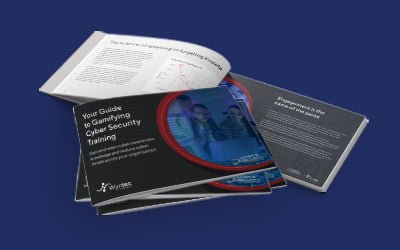Emails have become an essential tool in both our personal and professional lives. We use it to communicate with friends, family, colleagues, and clients. Many companies use it to share documents and data with vendors or partners. As emails remain a platform with a lot of activity, they have become a bigger target for cybercriminals to exploit.
While attacks like phishing emails are not new, we have moved beyond the obvious emails from 15 years ago – those telling you that you have won $1 million. Threat actors now leverage sneakier approaches, and your business needs the tactics to keep up.
In this blog, I’ll explore some common email security threats your organisation faces and the basic and advanced email security measures that you can implement to safeguard against these threats. By understanding the risks and implementing solutions, your business can minimise the risk of email security breaches and protect valuable data.
What are some common email security threats?
Malware and ransomware can be spread through email attachments or links and can cause significant damage to a company’s computer systems. They can result in data loss, system downtime, financial losses and reputational damage. Here are some of the most common email security threats that your business must be aware of:
Phishing attacks
Cybercriminals use phishing emails to trick employees into providing sensitive information such as login credentials, financial information, or personal data. These attacks often come from someone pretending to be a trusted person or business and a large group of people might receive the same email.
Email spoofing and social engineering tactics
Cybercriminals use email spoofing to impersonate a trusted sender and trick specific people into providing sensitive information or taking harmful actions. Social engineering tactics involve psychological manipulation to deceive people into divulging confidential information or clicking on malicious links.
Business email compromise (BEC)
BEC attacks involve cybercriminals gaining access to a legitimate account and impersonating business or person, such as a vendor or CEO, to obtain sensitive information or initiate fraudulent transactions. These attacks are highly targeted and can be challenging to detect, resulting in significant financial losses.
Best practices for strengthening email security
As the volume of email communication increases, the risk of email security breaches also grows. Therefore, it is essential to implement effective email security measures to protect personal information and sensitive business data.
Password security and management
One of the most basic email security measures is password security and management. Your team should use strong passwords, ideally generated and stored by a password management tool. People should also avoid sharing passwords with colleagues.
Multi-factor authentication (MFA)
Your team should enable MFA to add an extra layer of security to email accounts. With MFA, users must provide two forms of identification before gaining access to their account: a password and a code sent via text message, email, or a separate app. Even if someone’s password becomes compromised, MFA can prevent unauthorised access.
Email filtering and spam protection
Email filtering and spam protection are essential security measures that can prevent phishing attacks and other malicious email activities. Email filtering automatically identifies and removes spam, emails with malware, or other unwanted messages. By using these email filtering and spam protection tools, your business can significantly reduce the risk of email security breaches.
Employee training and education
Finally, employee training and education are one of the most critical email security best practices. You should educate your team on email security practices and provide regular training to help them stay up-to-date with the latest threats. Your team should receive training on recognising phishing emails and other malicious activities and how to report any suspicious emails.
Advanced email security measures
While basic email security measures such as password management and encryption are essential, they are often insufficient to protect against advanced email security threats. Advanced email security measures leverage cutting-edge technology to detect and prevent email security threats.
Cloud-based email security solutions
These are becoming increasingly popular as they provide advanced threat detection and protection while minimising the need for on-premises hardware and software. These solutions use a combination of advanced email filtering, encryption, and anti-malware to protect against a wide range of email security threats.
Artificial intelligence and machine learning-based email security systems
AI and ML use sophisticated algorithms and data analysis to detect and prevent email security threats such as phishing attacks, malware, and spam. By analysing patterns in email traffic and user behaviour, these systems can identify potential threats and take action to mitigate them.
Behaviour-based email threat detection
Behaviour-based email threat detection is another advanced email security measure that analyses user behaviour to identify potential threats. It analyses patterns, such as emails sent and received, to identify anomalies that may indicate a security threat. By detecting and responding to potential threats in real-time, behaviour-based email threat detection can prevent email security breaches before they become larger problems.
Endpoint security and data loss prevention
Endpoint security and data loss prevention (DLP) are advanced email security measures that focus on protecting against email-based security breaches. Endpoint security involves securing the devices that access email, such as laptops, smartphones, and tablets, to prevent unauthorised access and data theft. DLP involves monitoring email traffic and attachments to prevent sensitive data from being sent outside the organisation.
Conclusion
Email security is an essential aspect of online security that you must not overlook. As email becomes more prevalent in our personal and professional lives, the risk of email security breaches also increases.
Basic email security measures such as password management, encryption, and spam filtering are essential to protect against common email security threats such as phishing attacks and malware. However, as threat actors become more sophisticated, advanced email security measures such as cloud-based email security solutions, AI and ML, behaviour-based threat detection, endpoint security and DLP are becoming increasingly important.
By implementing basic and advanced email security measures, your organisation can minimise the risk of email security threats and keep email accounts and sensitive data secure.
Why choose Wyntec as your partner in email security?
Cyber security is on the priority list for many businesses now, and you must implement the right systems and solutions. One effective way to defend against email attacks is using email security solutions such as Egress Defend, which can detect and prevent malicious emails from reaching their intended targets. With Egress Defend, your business can provide employees with tools and training to help them identify and report suspicious emails.
We have recently partnered with Egress to deliver their solution for protection against advanced phishing attacks. Visit our Egress Defend page for more on the capabilities of this platform.
Related blogs
5 ways to strengthen your cyber security with Microsoft 365
The art of hacking the hackers: A guide to defending online security





